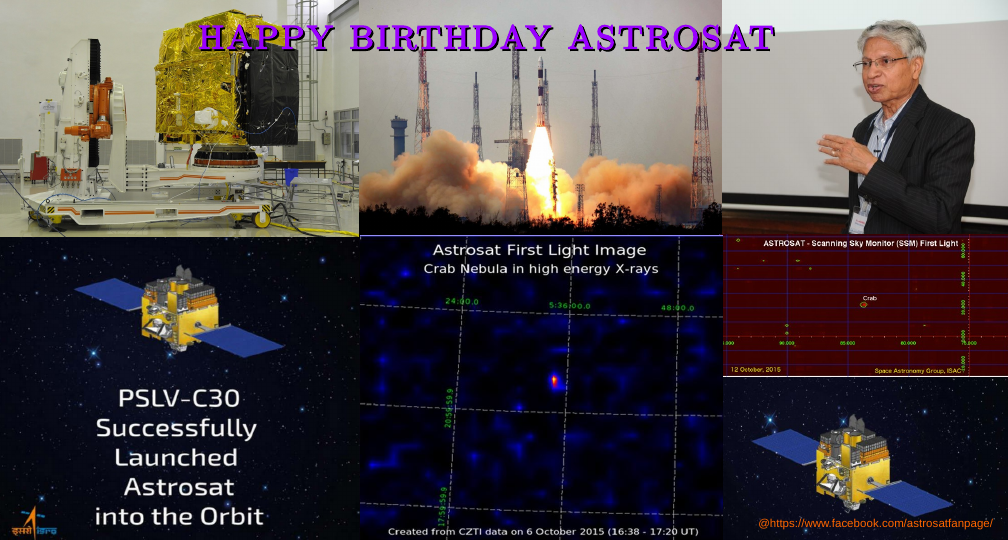ASTROSAT is India’s maiden multi-wavelength space mission to study the cosmos!
The observatory was launched on September 28, 2015 on board ISRO’s PSLV-C30 mission from the Satish Dhawan Space Centre in Sriharikota.
The multi-wavelength “eyes” of ASTROSAT include stunning features like an all-sky X-ray camera (SSM), X-ray and Ultraviolet pointed telescopes (Soft X-ray Telescope (SXT), Large Area X-ray Proportional counter (LAXPC), Cadmium Zinc Telluride Imager (CZTI), and Ultra Violet Imaging Telescope (UVIT)).

In simple terms, the ASTROSAT can observe X-rays coming from different cosmic sources such as X-ray binaries, black hole sources, Active Galactic Nuclei (AGNs) etc. and help us understand how some of these sources behave on a day-to-day basis, thereby unravelling the energetic phenomena which produce high energy radiations in the cosmos surrounding us.
Besides, the X-ray detectors can help estimate the magnetic field of Neutron stars, discover transient X-ray sources and so on. The crucial advantage is that it can simultaneously observe all these sources in the ultraviolet wavelength as well provide additional missing clues to help us solve some exciting mysteries of our universe.
The idea was conceived about two decades ago in the late 1990s by Prof. P.C. Agrawal and his team working at the Tata Institute of Fundamental Research, Mumbai and ISRO.
It is a lesser known fact that ASTROSAT had a pathfinder mission known as the Indian X-ray Astronomy Experiment (IXAE), which was an experimental X-ray mission onboard the Indian Remote Sensing Satellite IRS-P3 launched on March 21, 1996.
The mission was highly successful in studying many intriguing cosmic X-ray sources in a matter of just a few months. The payload worked for almost five years after which it was switched off. An exciting account of the birth of ASTROSAT titled “AstroSat: From Inception to Realisation and Launch” authored by Prof. Agrawal is available here.
Another popular article titled “ASTROSAT-Indian Multiwavelength Astronomy Satellite to View the Invisible Universe” by Prof. P.C.Agrawal is available in Physics News, July-December 2016 issue (Free download link).
During the last two years or so ASTROSAT has studied many cosmic X-ray sources, some of which are:
- Detection of coronal explosion from on our nearest exoplanet-hosting star, Proxima Centauri.
Source Image: NASA Goddard space flight center. Overlay: Red graph shows the observations made by the #TIFR team using Astrosat SXT. Green and blue graphs correspond to observations made by Chandra and Hubble, respectively - ASTROSAT’s maiden detection of a gamma-ray burst using CZTI instrument.
Credit: ASTROSAT/ISRO - UVIT image of star cluster from faint dwarf galaxy Wolf-Lundmark-Melott.
- Narrowing down of gamma-ray flash region using CZTI instrument from electromagnetic counterpart of gravitational waves (GW170817) emitted from NS-NS collision.
The detection of gravitational waves from NS-NS collision and electromagnetic counterpart opens up a new domain of multi-messenger astronomy in which ASTROSAT can play a crucial role in observing future events and improve our understanding about such explosive events. Besides, it will certainly improve our understanding about our X-ray Universe.
Download a free copy of the ASTROSAT book released by ISRO here.
Featured image courtesy Facebook.
Promote Science has all answers to your queries! Please write to us at promotoscience2020@gmail.com and follow us on social media.
Like this story? Or have something to share?
Write to us: contact@thebetterindia.com
Connect with us on Facebook and Twitter.
NEW: Click here to get positive news on WhatsApp!
If you found our stories insightful, informative, or even just enjoyable, we invite you to consider making a voluntary payment to support the work we do at The Better India. Your contribution helps us continue producing quality content that educates, inspires, and drives positive change.
Choose one of the payment options below for your contribution-
By paying for the stories you value, you directly contribute to sustaining our efforts focused on making a difference in the world. Together, let's ensure that impactful stories continue to be told and shared, enriching lives and communities alike.
Thank you for your support. Here are some frequently asked questions you might find helpful to know why you are contributing?

